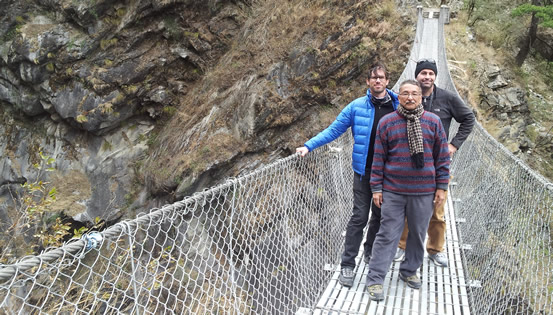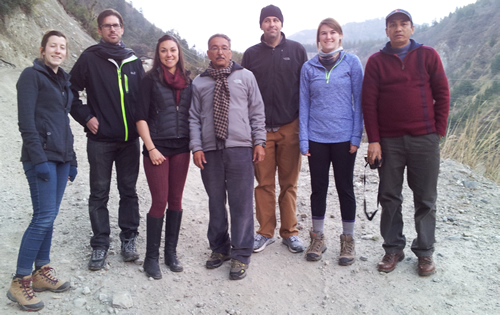After the two back-to-back earthquake shocks in April 25th and May 12th, the numbers that emerged in Nepal are staggering: more than 8000 deaths, three million displaced, 700,000 homes destroyed, 20,000 schools in ruin, more than 600 rural clinics leveled, several massive landslides (more than 500), picturesque towns obliterated, and many cultural heritage sites (more than 500) damaged reduced to rubble. After carrying out the initial rescue and relief efforts to supply food, shelters, and medicine by the government and relief agencies, Nepal is gradually entering into a phase of recovery and reconstruction. The success of Nepal’s recovery effort from this calamity will depend on our ability to understand the way our communities had co-existed with its physical and biological environment.
Research Mission
Various post-earthquake observations and studies done by an organization like the USGS shows a growing concern that the Himalayan landscape will continuously be vulnerable to earthquake induced future disasters such as the building collapses, the landslides and the threats of dams and flooding. Under such a risky environment, we have to pay attention to the concept of resilience in a more multi-faceted way: geo-physical or ecological resiliency, engineering resiliency, and, human behavioral adaptation resiliency. That is, using tools of natural sciences and social sciences, this NSC's initiative aims to approach the idea of post-earthquake recovery and reconstruction from the point of view of the rebuilding community resilience.
The Team
Under the aegis of the NSC (UNM) and its network of collaborators in the region, an interdisciplinary team was formed to study the climate issues in the Himalayas. Following a NSF funded research travel trip to Nepal (Bohara, Galewsky, abd Stone), the team was broadly brought under the umbrella of the Lumbini Center for Sustainability group. The UNM group in particular, the Himalayan Climate Change Impact Initiative , consists of faculty from various departments: Dr. Alok K. Bohara (Professor, Department of Economics), Dr. Joe Galewsky (Associate Professor, Department of Earth and Planetary Sciences), Dr. Mark Stone (Assistant Professor, Department of Civil Engineering), Dr. Christopher Lippitt (Assistant Professor, Geography and Environmental Studies) and many others. There are many scholars from other countries (Nepal, China, and India) interested in the general theme of the climate change and sustainability (Lumbini Center for Sustainability).
There are many students interested in this collective initiative from all of these departments: Jennifer Van Osdel, Lauren Jaramillo, Lauren Wheeler, Samrat Kunwar, Wenmei Guo, Dr. Menuka Karki, Dr. Naresh Nepal, Veeshan Rayamajhee, Rajan Bishwakarma, Soumi Roy Chowdhury just to name a few.


Geo-physical
- Loss of forest: Impacts on the community forest and overall Nepal’s forest.
- Water crisis: Impact on rivers, lakes (two streams dried out in/around Gorkha, Barpak area).
- Landscape: Shifts in the landscape due to the quakes (Mt. Everest and Kathmandu city are reported to have suffered with such shifts), impacts on dry landslides caused by the quakes. Langtang is completely destroyed by the quakes.
- Farming: Impacts on crops and livestock.
- Preparedness: Risk/Uncertainties and insurance.
Engineering Science: Infrastructures damages and recovery efforts
- Roads and bridges: Assessments of impacts on roads and bridges.
- Hydropower: Assessments of impacts on the dams and tunnels using sonar technology.
- Rebuilding houses and other infrastructures that are more resilient to future earthquakes.
- Seekingmarket solution, understanding risk and uncertainty, and coping with the situation.
Community Coping and Human Response
- Post-disaster trauma: Impacts on physical as well as mental health conditions.
- Pollution: Dry landslides and demolition of physical structure in and around city/villages.
- Solid waste and Sanitation issues: Many people are forced to live in the tents outside their home resulting in solid waste disposal problems in addition to food and drinking water issues.
- Developing the idea of one clinic, one school and one temple: building social capital, engaging women, developing the core of the economy has multiplier effect on the larger part of the economy.
- Try to uplift the community by making it more resilient in living in such a situation by understanding the science of it (quality of soil, danger of earthquake, geophysical structure of the landscape).
UNM4Nepal and PNMF have started working on designing suitable and affordable houses to be built in two different areas with different geo-physical characteristics: 1) Bawanepati (by the river with sandy and gravel soil) and 2) Khawa (clay) .
